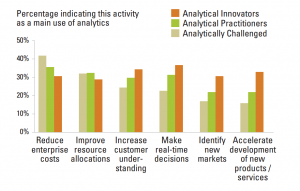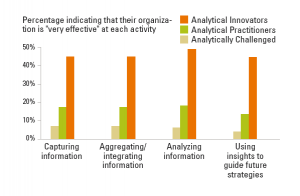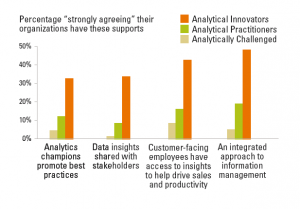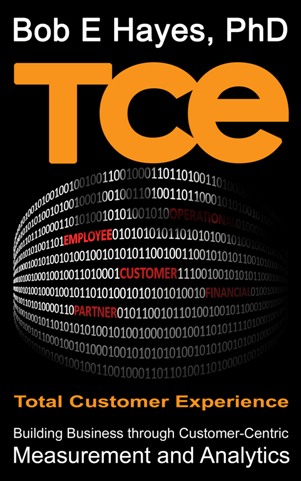Companies continually look for ways to outperform their competitors. One way is to apply analytics to their treasure trove of data. Researchers, for example, have found that top-performing businesses were twice as likely to use analytics to guide future strategies and guide day-to-day operations compared to their low-performing counterparts. Earlier this year, MIT and SAS released the results of a study which identified some of the reasons behind these differences. They surveyed 2500 respondents (55% being executives) across a variety of industries about how their organizations use data to advance their business objectives.
Three Ways to Improve the Value of Analytics for your Business
The researchers compared Analytical Innovators (businesses where analytics created a competitive advantage and has helped innovation) with Analytically Challenged (businesses where analytics did not create a competitive advantage and did not help innovation). They found that Analytical Innovators adopted different analytic practices compared to Analytically Challenged. According to their findings, if you want to be an Analytical Innovator, you need to:
1. Use analytics to solve customer-centric problems rather than company-centric problems

Figure 1. Analytical Innovators use analytics differently. Figure from MIT/SAS report: From Value to Vision: Reimagining the Possible with Data Analytics.
Analytical Leaders mainly use analytics to address issues that directly impact the customers: improve customer understanding, identify new markets, accelerate development of new products/services and make real-time decisions (see Figure 1). Analytically Challenged, on the other hand, primarily use analytics to address problems about internal matters: reduce costs and improve resource allocation. Unless those actions impact the customer experience (e.g., savings redirected toward product development), addressing those problems do not help improve long-term customer relationships.
One way to improve customer understanding is to collect customer feedback. Consider including customer experience (CX) metrics as part of your analytics strategy. Using various CX metrics as part of your analytics will help you identify business areas that matter to your customer and ways to improve customer loyalty.
2. Aggregate/Integrate your business data

Figure 2. Analytical Innovators are very effective at capturing, aggregating, analyzing and gaining insight from data compared to their counterparts. Figure from MIT/SAS report: From Value to Vision: Reimagining the Possible with Data Analytics.
Analytical Innovators, more so than their counterparts, are more effective at capturing, analyzing and gaining insights from data (see Figure 2). More importantly, they are more effective at aggregating/integrating data. In the world of Big Data where businesses have access to a wide variety of disparate data, data aggregation and integration becomes paramount. I found that businesses that integrate different data (i.e., operational, financial, constituency) with the customer feedback data have higher customer loyalty rankings within their industry compared to businesses who do not integrate their data with customer feedback. Taking a customer-centric data integration approach to analyzing your business data can help you uncover deeper customer insights to help you understand the causes and consequences of customer satisfaction and loyalty.
3. Support the sharing of analytic best practices and insights throughout the company

Figure 3. Analytical Innovators experience much support in the dissemination of data insights. Figure from MIT/SAS report: From Value to Vision: Reimagining the Possible with Data Analytics.
As seen in Figure 3, Analytical Innovators report that their organization supports the sharing of analytics across the company. By supporting the integration of data insights throughout the company, Analytical Innovators are less likely to make decisions based on hunches about what they think is happening; instead, they are better able to draw fact-based conclusions and allow employees and stakeholders to use those insights to drive both tactical and strategic decision-making, respectively.
Summary
Data analytics play a critical role in helping businesses create a competitive advantage and drive innovation. The MIT/SAS study showed that, to maximize the value of analytics, you need to:
- Use analytics primarily to increase value to the customer rather than to decrease costs/allocate resources.
- Aggregate/Integrate different business data silos and look for relationships among once-disparate metrics.
- Gain executive support around the use of analytics to encourage sharing of best practices and data-driven insights throughout your company.
Analytical Innovators use data differently than their counterparts. While the specifics may vary from Innovator to Innovator, common themes emerge across these analytical leaders. For the interested reader, I recently provided a case study (see: The Total Customer Experience: How Oracle Builds their Business Around the Customer) that illustrates how one company uses these analytical best practices to help improve the customer experience and increase customer loyalty.
————————–
Buy TCE: Total Customer Experience at Amazon >>
In TCE: Total Customer Experience, learn more about how you can integrate your business data around the customer and apply a customer-centric analytics approach to gain deeper customer insights.





 Beyond the Ultimate Question
Beyond the Ultimate Question Measuring Customer Satisfaction and Loyalty (3rd Ed.)
Measuring Customer Satisfaction and Loyalty (3rd Ed.)
Organizations that are focused on the customer experience above all else are the ones that will maintain success for the long haul. It’s less expensive to keep a happy client or customer as opposed to obtaining a new client or customer. This is why the voice of the customer needs to be monitored and strategies should be adapted based on the data.
What are some examples of customer centric versus business centric problems than you see in using analytics?